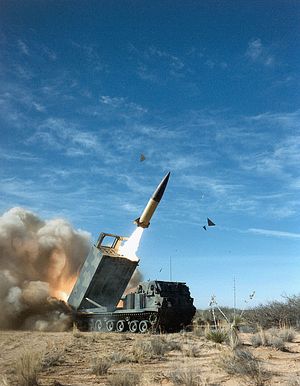At some point in 2019, the U.S. military will conduct its first-ever test a missile system off the Japanese island of Okinawa. According to a report by Japan’s Sankei Shimbun newspaper, the United States has informed the Japan Self-Defense Force of upcoming plans to conduct a missile test off Okinawa later this year.
The test comes amid increasing tensions between the United States and China and will underline the role that U.S. military assets on and around the first island chain might play in a possible future conflict in the East China Sea or around Taiwan.
The missile system that will be involved in the test will be the MGM-140 Army Tactical Missile System (ATACMS) off the U.S. Army’s M142 High-Mobility Artillery Rocket System (HIMARS) launcher, the Sankei Shimbun reported. The system is a road-mobile close-range ballistic missile system with a range capability of around 300 kilometers.
The ATACMS surface-to-surface missile, manufactured by Lockheed Martin, is one possible payload for the M142 HIMARS launcher. HIMARS itself is capable of functioning as a multiple launch rocket system (MLRS) for six rockets or a single ATACMS missile with a larger payload.
The system has undergone innovative types of testing in recent years. In October 2017, the U.S. Marine Corps conducted a HIMARS test off the deck of the USS Anchorage, an amphibious transport dock, against a land-based target.
The system is designed to offer a highly precise strike capability against land-based targets, making it optimal at taking out critical onshore facilities. The U.S. Army and Marine Corps are also exploring the possibility of an anti-ship missile for the HIMARS launcher.
During the 2018 iteration of the Rim of the Pacific (RIMPAC) exercises, the U.S. Navy conducted a sinking exercise using several HIMARS guided artillery rockets. The missiles were launched from a land-based HIMARS launcher.
The U.S. test takes on additional significance in light of the Trump administration’s decision to withdraw from the Intermediate-Range Nuclear Forces Treaty with Russia. That Treaty prohibited either side from developing, possessing, or testing ballistic and cruise missiles with range capabilities between 500 km and 5,500 km.
Following years of U.S. allegations of a Russian violation of the Treaty—through the development and deployment of a missile known as the SSC-8—the Trump administration informed Moscow that it will leave the treaty this year.
After U.S. withdrawal from the Treaty, Washington may look to develop a new kind of missile that was previously restricted by the treaty amid concerns about China’s military. Okinawa would be a candidate for the eventual deployment of these kinds of weapons, provided that the Japanese government and local Okinawan government were able to politically accept these kinds of U.S. deployments.
The U.S. military presence in Okinawa has run into considerable friction with local Okinawans. The island of Okinawa comprises less than 1 percent of Japanese territory, but hosts nearly three-fourths of all U.S. military installations and personnel stationed in the country already.

































